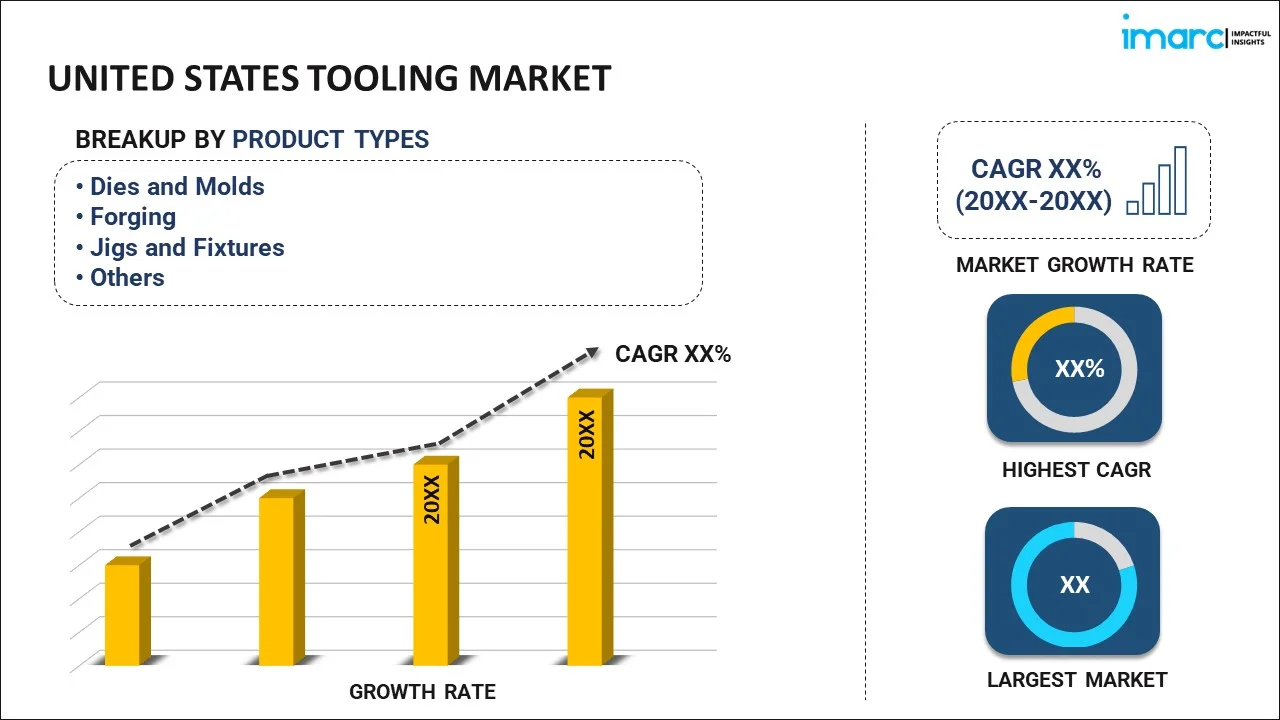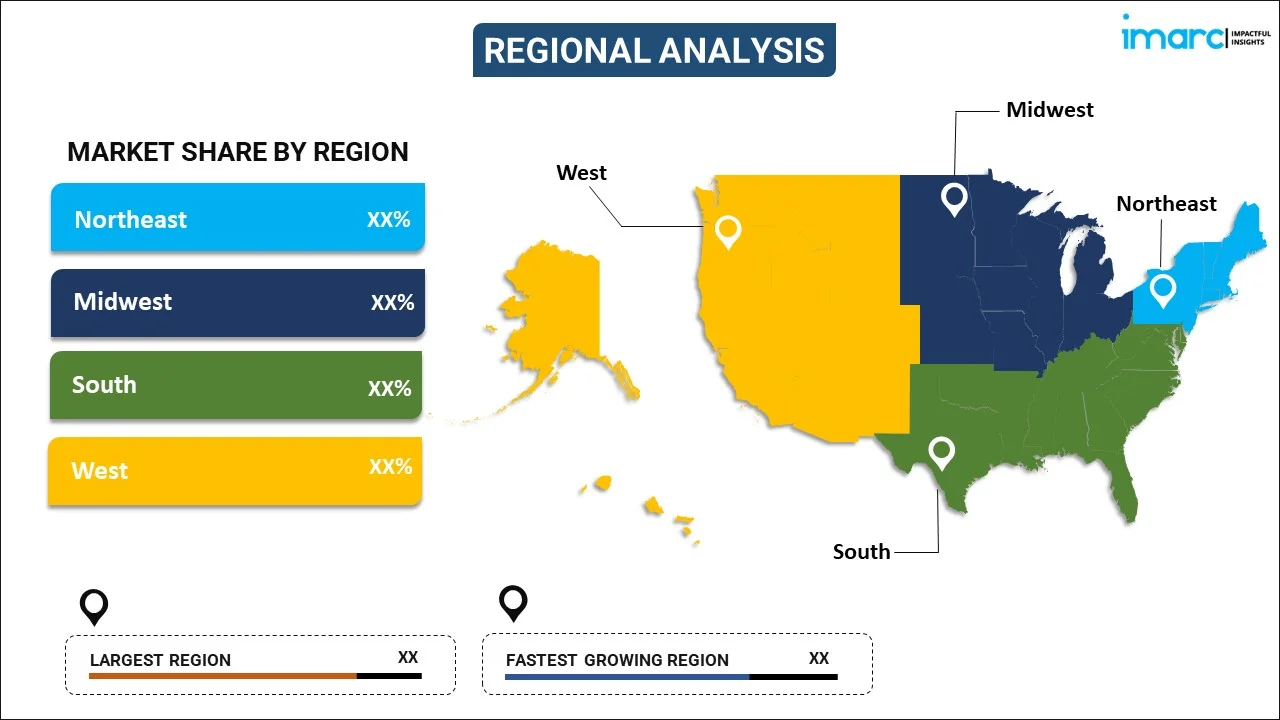
United States Tooling Market Report by Product Type (Dies and Molds, Forging, Jigs and Fixtures, Machines Tools, Gauges), Material Type (Stainless Steel, Iron, Aluminum, and Others), End Use Industry (Automotive, Electronics and Electrical, Aerospace, Marine and Defense, Plastics Industry, Construction and Mining, and Others), and Region 2025-2033
United States Tooling Market Overview:
The United States tooling market size reached USD 48.7 Billion in 2024. Looking forward, IMARC Group expects the market to reach USD 80.2 Billion by 2033, exhibiting a growth rate (CAGR) of 5.2% during 2025-2033. The rising need for sophisticated and durable tools to cater to the growing demand for precision-engineered components, the augmenting demand for building critical components with complex geometries compliant to stringent quality requirements, and the rising trend of micro-manufacturing represent some of the key factors driving the market.
|
Report Attribute
|
Key Statistics
|
|---|---|
|
Base Year
|
2024 |
|
Forecast Years
|
2025-2033
|
|
Historical Years
|
2019-2024
|
| Market Size in 2024 | USD 48.7 Billion |
| Market Forecast in 2033 | USD 80.2 Billion |
| Market Growth Rate (2025-2033) | 5.2% |
United States Tooling Market Insights:
- Major Market Drivers: United States Tooling Market is driven by the need for precision and performance in industries such as aerospace and automotive, where higher materials like carbide, ceramics, and high-speed steel improve tool life, cutting accuracy, and cost-effectiveness.
- Key Market Trends: Implementation of Industry 4.0 technologies, such as real-time monitoring and predictive maintenance, combined with hybrid tooling and modular systems, is transforming U.S. tooling market trends by empowering more intelligent, adaptive, and highly effective production processes across manufacturing industries.
- Competitive Landscape: Market participants are keen on creating application-specific tooling, taking advantage of digital design, and improving customer service. The environment is tending towards more innovation-based, with emphasis placed on speed, customization, and eco-friendly tooling technologies to address changing industrial needs.
- Opportunities and Challenges: Supply volatility of raw materials, pressures on tool costs, and shortages in workers' skills pose threats to expansion, whereas increased automation, lightweight component demand, and intelligent tool solutions offer huge potential for expansion in the future for the U.S. tooling business.
Tooling refers to the process of designing and engineering the tools that are necessary to manufacture parts or components. It includes a broad array of devices and equipment such as cutting tools, fixtures, molds, dies, jigs, gauges, and other tools that are used to shape raw materials into parts and products. These tools are specifically designed and engineered to carry out various manufacturing processes such as cutting, drilling, milling, turning, molding, stamping, forging, casting, and more. Tooling devices are typically characterized by their durability, precision, and capability to withstand rigorous conditions. They are designed to work under high pressure, heat, and speed. Tooling devices are often custom-made to suit specific manufacturing needs, ensuring that each tool fits its purpose perfectly. Tooling devices are made from a range of materials, including high-speed steel, carbide, ceramics, polycrystalline diamond, and more. These materials are chosen based on their hardness, toughness, wear resistance, and heat resistance. The use of proper tooling in manufacturing processes offers several advantages, such as increasing the efficiency and speed of the production process, improving productivity, higher quality end-products, and mass production of components with complex geometries.
United States Tooling Market Trends:
Increased Implementation of Advanced Materials in Tooling Applications
One of the characterizing United States tooling market trends is the amplifying application of advanced materials such as tungsten carbide, ceramics, and high-speed steel to support tooling performance in various industries. As per the sources, in March 2024, U.S. cutting tool makers started adopting hybrid tools, new materials such as CBN and ceramics, and Industry 4.0 integration, foreshadowing smarter, stronger, and greener tooling innovations across the industry. Moreover advanced materials are more resistant to wear, heat, and cutting errors, which are essential for aerospace, automotive, and medical device industries. As parts become more sophisticated and tolerances close, manufacturers are turning towards reliable and strong tooling solutions in order to sustain productivity. This shift is not only making processes more efficient but also decreasing tool replacement cycles, which translates directly to cost savings for operations. The market demand is directly correlated to these advancements since more businesses look for material solutions to increase tool longevity in high-stress and high-speed applications. Moreover, this trend seems delicate, but it is profoundly impacting the strategies for procurement. Therefore, investments in material science and tooling research and development (R&D) will continue to be crucial to maintaining long-term United States tooling market growth.
Shift Towards Custom and Modular Tooling Systems
A heightening demand for customization and modularity is propelling innovation within the United States tooling industry. Firms are looking more for tooling systems designed to meet individual production needs—whether high-volume, rapid prototyping, or specialty parts. Modular tooling permits flexibility, rapid tool changeover, and responsiveness across a wide range of production lines. This is consistent with lean manufacturing and enables agile flows that become more of a requirement in the competitive marketplace. This innovation is revolutionizing the United States tooling market outlook, allowing manufacturers to lower downtime and increase throughput. Through the delivery of flexible, scalable solutions, toolmakers are coming out on top and enhancing the market share across several verticals. In addition, this trend indicates a larger shift toward user-driven tooling design, where the convergence of toolmaker and end-user collaboration results in increased production accuracy and speed. With increasing demand for adaptable solutions, this modular strategy is transforming the United States tooling market analysis.
Digitalization and Simulation in Tooling Design
Digitalization of tooling processes, especially through CAD/CAM software and virtual simulation, is transforming tooling development and deployment in U.S. industries. Simulation tools enable manufacturers to forecast tool wear, optimize shapes, and experiment with designs virtually before actual production starts. This digital-first strategy shortens lead times, decreases trial-and-error expense, and increases accuracy. Such productivity gains become more important as manufacturers try to optimize operations and stay competitive. The United States tooling market forecast indicates robust prospects for expansion in digital tooling usage, particularly as automation becomes mainstream. Moreover, digital integration enables the development of closed-loop feedback between tooling and production for continuous improvement. At a distance, these shifts might appear technical, but they represent transformative efficiency at scale. As companies digitally optimize their workflows, the analysis highlights this trend as a cornerstone of innovation and competitiveness in future manufacturing strategies.
United States Tooling Market Segmentation:
IMARC Group provides an analysis of the key trends in each segment of the United States tooling market report, along with forecasts at the country level for 2025-2033. Our report has categorized the market based on product type, material type and end use industry.
Product Type Insights:

To get more information on this market, Request Sample
- Dies and Molds
- Forging
- Jigs and Fixtures
- Machines Tools
- Gauges
The report has provided a detailed breakup and analysis of the market based on the product type. This includes dies and molds, forging, jigs and fixtures, machines tools, and gauges.
Material Type Insights:
- Stainless Steel
- Iron
- Aluminum
- Others
A detailed breakup and analysis of the market based on the material type has also been provided in the report. This includes stainless steel, iron, aluminum, and others.
End Use Industry Insights:
- Automotive
- Electronics and Electrical
- Aerospace, Marine and Defense
- Plastics Industry
- Construction and Mining
- Others
A detailed breakup and analysis of the market based on the end use industry has also been provided in the report. This includes automotive, electronics and electrical, aerospace, marine and defense, plastics industry, construction and mining, and others.
Regional Insights:

- Northeast
- Midwest
- South
- West
The report has also provided a comprehensive analysis of all the major regional markets, which include Northeast, Midwest, South, and West.
Competitive Landscape:
The report has also provided a comprehensive analysis of the competitive landscape in the United States tooling market. Competitive analysis such as market structure, key player positioning, top winning strategies, competitive dashboard, and company evaluation quadrant has been covered in the report. Also, detailed profiles of all major companies have been provided.
Latest News and Developments:
- In June 2025, Heimatec's internal coolant live tools were launched by Platinum Tooling throughout the United States, with a pressure of up to 2000 psi. Aerospace and hardened material use is targeted in these tools that enhance heat control, chip removal, and tool life. They are compatible with leading CNC machines and accommodate quick-change install.
- In September 2024, Kennametal presented its newest tooling developments at IMTS in Chicago, including live demonstrations of machining with the SVM 4100 Vertical Machining Center and product exhibitions from Kennametal, WIDIA, and Hanita, showcasing innovations in modular drilling, ceramic grades, and application-optimized tooling solutions for manufacturers in the U.S.
United States Tooling Market Report Scope:
| Report Features | Details |
|---|---|
| Base Year of the Analysis | 2024 |
| Historical Period | 2019-2024 |
| Forecast Period | 2025-2033 |
| Units | Billion USD |
| Scope of the Report | Exploration of Historical and Forecast Trends, Industry Catalysts and Challenges, Segment-Wise Historical and Predictive Market Assessment:
|
| Product Types Covered | Dies and Molds, Forging, Jigs and Fixtures, Machines Tools, Gauges |
| Material Types Covered | Stainless Steel, Iron, Aluminum, Others |
| End Use Industries Covered | Automotive, Electronics and Electrical, Aerospace, Marine and Defense, Plastics Industry, Construction and Mining, Others |
| Regions Covered | Northeast, Midwest, South, West. |
| Customization Scope | 10% Free Customization |
| Post-Sale Analyst Support | 10-12 Weeks |
| Delivery Format | PDF and Excel through Email (We can also provide the editable version of the report in PPT/Word format on special request) |
Key Benefits for Stakeholders:
- IMARC’s report offers a comprehensive quantitative analysis of various market segments, historical and current market trends, market forecasts, and dynamics of the United States tooling market from 2019-2033.
- The research study provides the latest information on the market drivers, challenges, and opportunities in the United States tooling market.
- Porter's five forces analysis assist stakeholders in assessing the impact of new entrants, competitive rivalry, supplier power, buyer power, and the threat of substitution. It helps stakeholders to analyze the level of competition within the United States tooling market industry and its attractiveness.
- Competitive landscape allows stakeholders to understand their competitive environment and provides an insight into the current positions of key players in the market.
Key Questions Answered in This Report
The tooling market in the United States was valued at USD 48.7 Billion in 2024.
The United States tooling market is projected to exhibit a CAGR of 5.2% during 2025-2033, reaching a value of USD 80.2 Billion by 2033.
The principal drivers of the United States are technological progress, robust consumer demand, sound infrastructure, and a vibrant labor force. Moreover, favorable government policies, rich natural resources, and international leadership in finance and defense underpinning sustained economic performance, competitiveness, and global influence across various sectors.
Need more help?
- Speak to our experienced analysts for insights on the current market scenarios.
- Include additional segments and countries to customize the report as per your requirement.
- Gain an unparalleled competitive advantage in your domain by understanding how to utilize the report and positively impacting your operations and revenue.
- For further assistance, please connect with our analysts.
 Request Customization
Request Customization
 Speak to an Analyst
Speak to an Analyst
 Request Brochure
Request Brochure
 Inquire Before Buying
Inquire Before Buying




.webp)




.webp)












